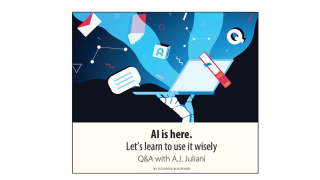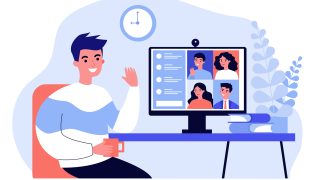By Karen Marklein, Rachael Milligan, and Julia Osteen
Until a few months ago, moving all student and adult learning online was unimaginable for many of us. Enter the COVID-19 pandemic and the sudden transition to that reality. Now more than ever, educators need high-quality professional learning that includes collaboration with colleagues, supports sustainable practices, and uses innovative tools and methods for doing so.
Working with school districts across the state of Tennessee and beyond, we had been facilitating distance learning sessions even before the pandemic because we know flexibility and autonomy are important to adult learners and sustainable professional learning offerings are important to districts. Once professional learning from a distance became a necessity, we were able to move seamlessly into a completely online learning community because we already had the structures and expectations in place. The shift was planning for this kind of learning over an extended period of time.
In all of our remote professional learning, we have prioritized maintaining and sustaining best practices. Our team developed a framework for professional learning from a distance that consists of three components: Communication, Chunking, and Community Building.
The framework draws on our experience, Learning Forward’s Standards for Professional Learning (2011), the seminal work of Knowles (1975), and current literature (Akyol and Garrison, 2008; Young, 2006; Snyder, 2009; O’Malley, 2017):
- Learning Forward’s Standards for Professional Learning (2011) highlight seven best practices including the use of communities of practice.
- Knowles’ (1975) information on adult learning emphasizes autonomy, honoring prior experience, goal-orientation, relevance, practicality, and collaborative environments.
- Akyol and Garrison (2008) suggest three principles of online delivery to support a community of inquiry: social presence, cognitive presence, and teaching presence.
The challenge – and the opportunity – was to attend to these principles, find a way to build the community needed for effective professional learning, and provide flexible delivery. The 3 C’s make that possible.
While these ideas are especially applicable during a time of social distancing and school closures, this framework for professional learning from a distance transcends the bounds of our current reality and can provide support for all professional learning facilitators even after the COVID crisis has passed.
Communication
Consistent and thoughtful communication has always been the hallmark of effective school leaders, and it is especially important during remote learning. As leaders of professional learning, we realized the importance of considering not only what we were communicating, but how and how often. It was important to ensure we were using opportunities for communication to build connections.
In our experience, it is an essential first step for a school district to establish a communication plan, including a consistent point of contact for logistics, as well as a timeline for synchronous meetings and any assignment deadlines.
After the plan is established, communication should be focused on expectations. Teachers need to know what is expected of them before, during, and after remote professional learning. A traditional delivery method of professional learning carries with it some implied expectations, but shifting to a remote delivery method requires leaders to consider the different expectations that result from the online environment. For example, leaders can communicate the expectation that teachers plan to engage in the learning session from a quiet space, remain active participants, have materials accessible, and attend to post-session learning opportunities or reflections.
Next, teachers need to know logistical details, such as start and end times, technology requirements, and other norms to govern their virtual time together. How long will you expect to be online? How will the session be structured? What device(s) would be preferable to use during the online learning session? Will participant microphones be in use? What kind of environment is most conducive to engage in learning?
Lastly, as Snyder (2009) asserts, it is important to define the purpose of the online professional learning community and communicate it as often and as clearly as possible. In our own professional learning, we have sought to embrace the new possibilities the online environment affords and expand our purposes. These new possibilities have allowed us to reach broader and more remote audiences and record and archive professional learning events.
Chunking
We know that chunking information is one of the best ways to anchor the information and ready the mind for application (O’Malley, 2017). Chunking can take place in several ways.
First, we have found we can make the most of participants’ time by blending asynchronous and synchronous professional learning strategies. One strategy is assigning pre-work ahead of a synchronous session. Learners have the autonomy to read or work on an assignment at their own pace, and they come to the distance-learning session prepared with informed thoughts and opinions and ready to contribute to the conversation. This helps facilitators make the most of limited time and also allows them to model a flipped learning environment, which many teachers are now experimenting within their classes.
Second, our experience has taught us that individuals learning in an online, synchronous session should be in front of a screen for no more than 2 to 2.5 hours at a time. Even in face-to-face professional learning sessions, it is ineffective to overload individuals with too much information at once and this is exacerbated in a setting where screens and headphones are the modes of communication and movement is limited (Snyder, 2009). We must also assume that individuals in these sessions may be working in an environment in which their attention could be divided. After 2.5 hours, participants in a distance learning session need both cognitive and physical breaks. Planning for these breaks helps keep participants engaged for meaningful amounts of time, while allowing them to take care of personal needs at regular intervals.
Third, chunking can be accomplished by giving additional assignments over an extended lunch break. While in a typical professional learning day, individuals may have an hour or so for lunch, distance learning offers a unique opportunity for participants to do more than eat. Facilitators could allocate two hours for lunch, which would include the traditional personal time to eat and take care of pressing business as well as time to read an article, complete a task, take a survey, watch a video, or engage in a practical learning experience of some kind. In this way, much like the principle of pre-work, individuals return to an afternoon session refreshed and prepared with new ideas.
Community building
Our favorite part of any professional learning opportunity is the chance to strengthen connections by building community. We know a focus on relationships between teachers and students yields positive learning results, and the same is true for adult learners. Distance learning makes this element of the framework even more important. In order to maximize the experience of our professional learning, we must maximize the connection between and among participants.
One way to build a connection is to start the session with a check-in question. This is a fun way to invite participation, encourage creativity, appreciate humor, and learn about colleagues. These check-ins can be personal or professional, or a little of both. Some of our favorite personal check-in questions are:
- “Other than education, what would your dream job be?”
- “Go to the 12th picture in your camera roll and share the significance of that picture.”
- “What is your sunshine today?”
- “What might be causing some clouds?”
- “What are you setting aside to be fully engaged today?”
We have also used check-ins to review learning or gauge expectations for a session. One of our favorites is the windowpane check-in. We organize participants into groups and ask them to take a closer look at an article, experience, or another content piece, using four prompts. This encourages reflection, collaboration, and synthesis of ideas. (We have also found this is most effective with participants starting in smaller groups, which we have been able to achieve using break-out rooms in our video-conferencing software.) Here is an example:
| What are your aha moments from our previous session?
|
Create a metaphor that compares new learning to something familiar. |
| What new learning are you anticipating today?
|
Who will you tell about your learning today? |
Regardless of the check-in question or activity, it is essential to set aside time and commit to checking in. It may be an investment of 10-15 minutes, but it will increase engagement (Akyol, & Garrison, 2008), build rapport, and cultivate a learner-centered environment (Snyder, 2009).
Throughout our professional learning, we encourage community-building by varying engagement strategies. At times, we specifically ask each participant to respond in a whole-group setting, but we also encourage community-building through small group discussions in breakout rooms. In these breakout room discussions, we provide structure and purpose through the use of discussion protocols. Lastly, we encourage community-building through storytelling by asking participants to apply the learning to their own context and share what that looks like.
See the possibilities
This framework allows professional learning facilitators to embrace the possibilities of professional learning from a distance. Our team has heeded the call to think differently about professional learning and our approach has been appreciated. One participant stated, “I had no idea that a completely virtual training could be so very interactive.” Districts can be more nimble to adapt to changing needs – pandemic-related or otherwise – if they consider high-quality distance learning options as part of their overall professional learning plans.
 Karen Marklein (karen.marklein@lipscomb.edu) is the program director for the Ayers Institute for Teacher Learning and Innovation and assistant professor in the College of Education, Lipscomb University. Rachael Milligan (rachael.milligan@lipscomb.edu) is managing director for the Ayers Institute and Assistant Dean in the College of Education at Lipscomb. Julia Osteen (julia.osteen@lipscomb.edu) is a technology integration specialist for the Ayers Institute and Instructor in the College of Education at Lipscomb.
Karen Marklein (karen.marklein@lipscomb.edu) is the program director for the Ayers Institute for Teacher Learning and Innovation and assistant professor in the College of Education, Lipscomb University. Rachael Milligan (rachael.milligan@lipscomb.edu) is managing director for the Ayers Institute and Assistant Dean in the College of Education at Lipscomb. Julia Osteen (julia.osteen@lipscomb.edu) is a technology integration specialist for the Ayers Institute and Instructor in the College of Education at Lipscomb.
References
Akyol, Z., & Garrison, D. (2008). The development of a community of inquiry over time in an online course: Understanding the progression and integration of social, cognitive and teaching presence. Journal of Asynchronous Learning Networks, 12, 3–22. https://dx.doi.org/10.24059/olj.v12i3.72
Knowles, M. (1975). Self-directed learning: A guide for learners and teachers. Englewood Cliffs, NJ: Cambridge. ISBN 0-8428-2215-1
Learning Forward. (2011). Standards for professional learning. Retrieved from https://learningforward.org/standards-for-professional-learning/
O’Malley, S. (2017). Effective Teaching Online. Inside Higher Ed.
Retrieved from https://www.insidehighered.com/digital-learning/article/2017/07/12/7-guidelines-effective-teaching-online
Snyder, M. M. (2009). Instructional-design theory to guide the creation of online learning communities for adults. TechTrends, 53(1), 48–56.
Young, S. (2006). Student views of effective online teaching in higher education. The American Journal of Distance Education, 20(2), 65–77. https://dx.doi.org/10.1207/s15389286ajde2002_2









